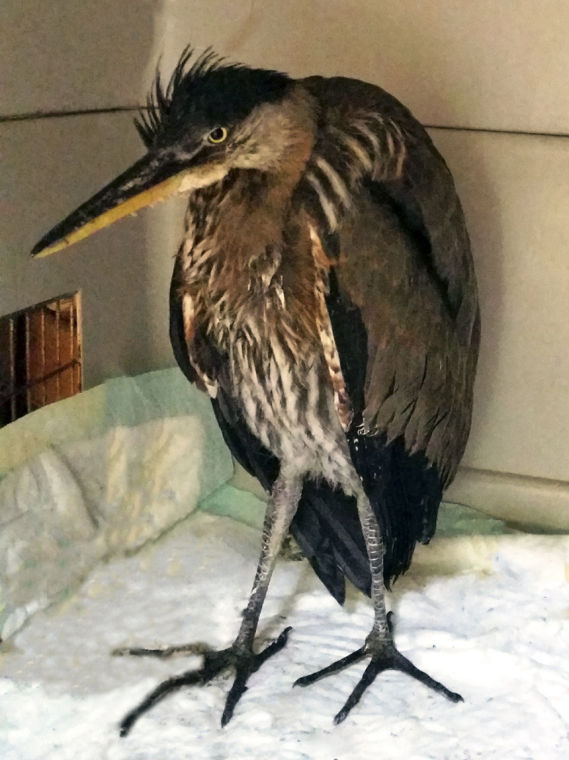In June, a boating inspector named Patricia came across a young great blue heron in the middle of the road at Coyote Lake-Harvey Bear Ranch County Park in San Martin. The bird couldn’t fly but was trying to hop across the road to get up an embankment. Concerned that it might get hit by a vehicle, Patricia brought the bird to the ranger station. Park ranger Seth Topping, who just happens to be a former WERC volunteer, contacted the Wildlife Education and Rehabilitation Center for advice on evaluating whether the bird needed to be rescued or should be returned to the lake. Because its attempts to strike and defend itself were slow and off the mark, Topping determined that it was probably too young or too malnourished to live if released. Patricia transported it to WERC.
At WERC, an examination showed no injuries, but the young heron was definitely very thin and very hungry. It was given emergency hydration and liquid supplements and then was hand-fed a variety of fish.
To protect themselves from its dagger-like bill while handling and feeding the heron, staff wore face shields and leather gloves. Because WERC does not have the facilities to house large water birds for an extended period, the heron was transferred to the International Bird Rescue in Fairfield, which specializes in the care of oiled, injured and orphaned aquatic birds. Once the juvenile bird plumps up and is ready to be released, it will be set free at an appropriate location where there is plenty of water—especially important during the drought—and a plethora of piscine prey.
Standing four-feet-tall, great blue herons are the largest of the North American herons with long legs and a sinuous, “S” shaped neck. Though this juvenile appears dark grey with streaking on its breast feathers, adult great blue herons have bluish-gray bodies, white faces and have long, black head plumes.
Great blue herons span most of North and Central America as well as the Caribbean and the Galápagos Islands. Their saltwater and freshwater habitats range from open coasts, kelp beds, marshes, sloughs, riverbanks, lakes and even backyard goldfish and koi ponds (a friend of mine has had an unfortunate experience witnessing her prized fish becoming fodder). They also forage in grasslands and agricultural fields. Hunting day and night, great blue herons wade slowly or stand motionless until they come within striking distance of their prey, which is mostly fish, but also amphibians, reptiles, insects and small mammals and birds. With a lightning-fast thrust, they stab the prey with their strong bill and swallow it whole.
The symbolism of the heron means different things to different cultures. In China, the heron represents strength, purity and long life. In Native American tradition, the heron is associated with wisdom. In Egypt, the heron is a symbol of creation while in Africa and Greece, the heron is a messenger of the gods. In Aztec mythology, the god Huitzilopochtli was sometimes known as “the blue heron bird” and was considered to be an incarnation of the sun.
Regardless of what they may symbolize, the tucked-in neck, trailing legs and six-foot wingspan of these beautiful and elegant birds presents a distinctive and magnificent image against the skies.










